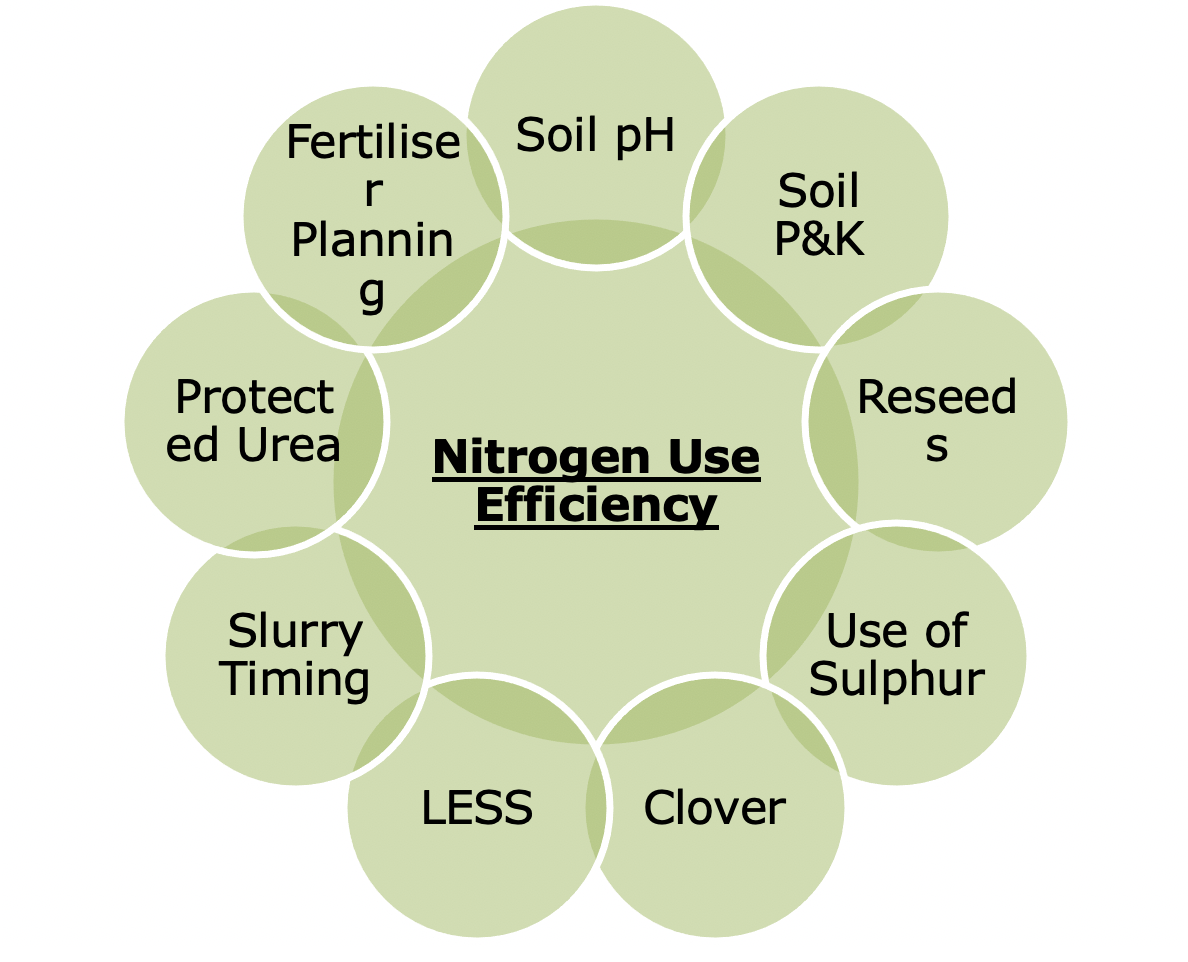Increasing Nitrogen Use Efficiency
Nitrogen Use Efficiency (NUE) is a term that we hear referenced more frequently and it can vary widely across different farms and production systems. NUE calculates all nitrogen (N) inputs on your farm versus the outputs and it can be used as a key indicator of farm efficiency.
Understanding what is Nitrogen Use Efficiency (NUE)
NUE is a calculation that measures how efficiently nitrogen in slurry, feed & fertiliser converts to milk and meat. Typically, the N sources on a farm come from chemical fertiliser, purchased feeds (concentrates and forage) and slurry. Chemical fertiliser is generally the biggest source; however, it is important to remember the lesser sources such as feed conversion in cattle and excreting nitrogen. The N outputs are equally important for the farm and these typically occur through milk sales, livestock and forage sales and exported slurry. Nitrogen use efficiency across Irish dairy farms is currently on average 25%, there is an target going forward to increase NUE to 35% on grassland farms in the coming years. By improving this figure there are many opportunities not only to improve water quality by reducing nitrogen losses through leaching, but also by reducing costs and increasing profitability at farm level.
Benefits of Increasing NUE
- Increases the sustainability of our farms.
- Improved usage of N inputs which will save money on input costs
- Reduced fertiliser usage which will reduce ammonia emissions helping to improve air quality as well as protect water quality.

Increasing NUE on Dairy Farms
There are many measures we can take at farm level to increase our current NUE figures. Management changes that can increase milk production from existing N use levels or maintains current levels of milk production using lesser amounts of N inputs will improve NUE on the dairy farms. The following are some of the measures for Irish dairy farms to help increase farm gate NUE and achieve the industry target of 35%
1. Better Utilisation of Organic Manures
By applying slurry in the spring using low emission slurry spreading (LESS) methods, increased quantities of N can be recovered, and thereby reducing chemical N fertiliser requirements. Spring applications using LESS will lead to a 50% increase in the availability of N when compared with the splash plate and a 50% increase in availability compared to summer applications.
2. Increase Soil Fertility
Sub-optimum soil fertility is a key factor that limits pasture production on many dairy farms because of reduced soil nutrient availability. Increasing soil fertility (pH 6.3 and index 3 for P and K) will make N more available in the soil resulting in a better response to applied nutrients and increased grass grown from less chemical fertiliser resulting in increased NUE.
3. Incorporate White Clover
The incorporation and management of white clover in grazing swards can significantly increase individual animal performance while also reducing requirements for chemical N application during the grazing season. A good clover sward can fix up to 150 kg of N per Ha. This reduction in chemical N requirements can significantly increase NUE.
4. Reduce Protein Level of Concentrates
As the crude protein (CP) content of grazed grass is normally in excess of 20% during summer, it will adequately meet the protein requirements of the herd. Reducing the CP content of the concentrate during the main grazing season is a significant opportunity to reduce N inputs and further increase NUE efficiencies.
5. Include Sulphur
Sulphur is a very important nutrient for grassland, and it is closely associated with nitrogen uptake and efficiency. Sulphur and nitrogen work closely together as grass grows, S is required to convert N to plant dry matter. Sandy, lighter soils with low organic matter tend to be more prone to S deficiency. For grazing a ratio of 12:1 for N and S is recommended and for silage crops 20kg/ha is recommended.
Sustainability Action Payment
Tirlán has committed to assist our dairy suppliers in reducing the carbon footprint, enhancing water quality and improving air quality and soil health of farms in line with our sustainability strategy, Living Proof. Many of the measures outlined in the Sustainability Action Payment will help increase Nitrogen Use Efficiency on farm.

First Published 11 April 2023
Tagged with: Dairy